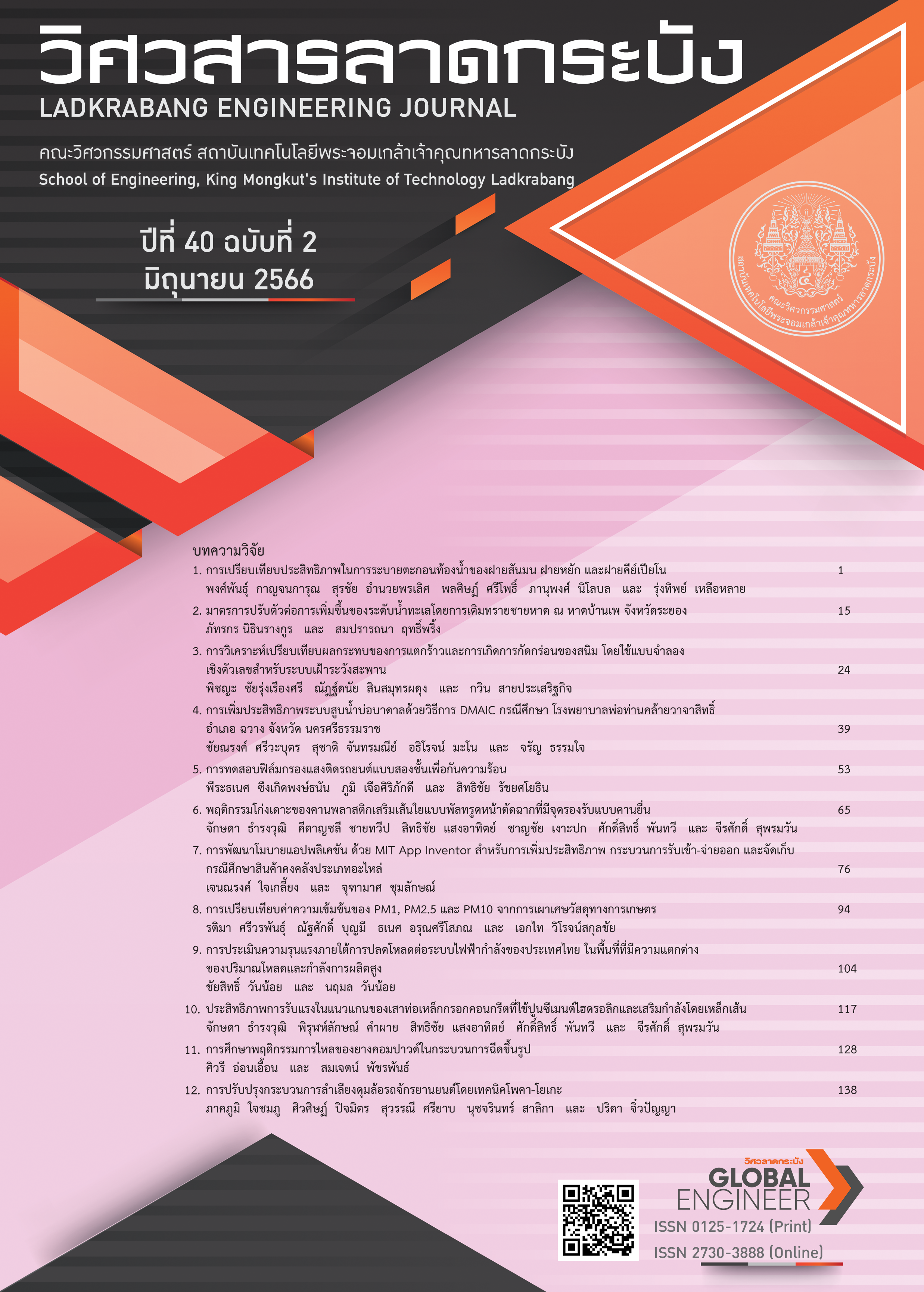Rhelogical Study of Rubber Compound during Injection Molding Process
Keywords:
Rheological behavior, Rubber compound, Injection molding, Process parameters, Flow simulation programAbstract
In this study, the effects of process parameters such as mastication time, shear rate, injection and mold temperatures, filler type and content on the rheological behavior of rubber compound were investigated. The influences of mold designs, i.e., type and size of runner were also studied in details. The measured results indicated that the viscosity of rubber compound tended to decrease with increasing shear rate. This was due to the pseudoplastic flow behavior of rubber compound. The results suggested that the increase of mastication time and injection temperature, which can be a source of rubber chain scission and relaxation, enhanced the flowability of rubber compound. On the other hand, the increasing mold temperature and amount of filler loadings tended to decrease the flowability. From the results obtained by using various sizes and cross-sectional area of flow channel, it can be seen that the square runner gave a better flowability as compared to that of half round runner where the higher heat transfer from mold wall can penetrate into the rubber compound. The smaller the size of runner, the lower the viscosity was observed which probably caused by a wall slip phenomenon. Furthermore, the effects of processing parameters on the flowability of rubber compound were extensively verified against the simulated results performed by the commercial simulation package (CADMOULD). The predicted result of flow length obtained from the 3D model was found to be higher than that of 2.5D model. However, the discrepancies were observed which resulted from the assumption of no slip boundary and isothermal flow utilizing in the simulation program.
References
S. C. Chen, R. I. Tsaia, R. D. Chien and T. K. Lin, “Preliminary study of polymer melt rheological behavior flowing through micro-channels,” International Communications in Heat and Mass Transfer, vol. 32, no. 3–4, pp. 501–510, 2005, doi: 10.1016/j.icheatmasstransfer.2004.07.004.
B. Xu, K. T. Ooi, T. N. Wong and C. Y. Liu, “Study in the viscosity of the liquid flowing in microgeometry,” Journal of Micromechanics and Microengineering, vol. 9, no. 4, pp. 377–384, 1999, doi: 10.1088/0960-1317/9/4/315.
G. R. Palmese and V. M. Karbhari, “Effect of sizing on microscopic flow in resin transfer molding,” Polymer Composites, vol. 16, no. 4, pp. 313–318, 1995, doi: 10.1002/pc.750160408.
C. E. Barnett, “Thermal properties of rubber compounds I. thermal conductivity of rubber and rubber compounding materials,” Industrial and Engineering Chemistry, vol. 26, no. 3, pp. 303–306, 1934, doi: 10.1021/ie50291a018.
S. Ngamsurat, K. Boonkerd, U. Leela-adison, and P. Potiyaraj, “Curing characteristics of natural rubber filled with gypsum,” Energy Procedia, vol. 9, pp. 452–458, 2011, doi: 10.1016/j.egypro.2011.09.051.
N. Sombatsompop “Rheological behaviors of molten polymer” in Polymer Rheology & Applications (Revised and Expanded Version), Bangkok, Thailand: KMUTT Press, 2005, ch. 2, pp.7–24.
S. -S. Choi, “Correlation of crosslink density with pyrolysis pattern of natural rubber vulcanizates with efficient vulcanizing cure system,” Journal of Analytical and Applied Pyrolysis, vol. 52, no. 1, pp. 105–112, 1999, doi: 10.1016/S0165-2370(99)00041-8.
R. -D. Chien, W. -R. Jong and S. -C. Chen, “Study on rheological behavior of polymer melt flowing through micro-channels considering the wall-slip effect,” Journal of Micromechanics and Microengineering, vol. 15, no. 8, pp. 1389–1396, 2005, doi: 10.1088/0960-1317/15/8/003.
C. -S. Chen, S. -C. Chen, W. -L. Liaw and R. -D. Chien, “Rheological behavior of POM polymer melt flowing through microchannels,” European Polymer Journal, vol. 44, no. 6, pp. 1891–1898, 2008, doi: 10.1016/j.eurpolymj.2008.03.007.
A. Lawal and D. M. Kalyon, “Viscous heating in non-isothermal die flows of viscoplastic fluids with wall slip,” Chemical Engineering Science, vol. 52, no. 8, pp. 1323–1337, 1997, doi: 10.1016/S0009-2509(96)00486-1.
N. Sombatsompop and W. Chaiwattanpipat, “Temperature distributions of molten polypropylene during injection molding,” Advances in Polymer Technology, vol. 19, no. 2, pp. 79–86, 2000, doi: 10.1002/(SICI)1098-2329(200022)19:2<79::AID-ADV1>3.0.CO;2-D.
W. Hofmann “Filler characteristics” in Rubber Technology Handbook, Hanser Publishers, New York, NY, USA, 1989, pp. 275–290.
B. Rodgers “General compounding” in Rubber Compounding; Chemistry and Application, New York, NY, USA: Marcel Dekker Inc., 1994, ch.8, pp. 365–378.
J. L. Leblanc, “Rubber-filler interactions and rheological properties in filled Compounds,” Progress in Polymer Science, vol. 27, no. 4, pp. 627–687, 2002, doi: 10.1016/S0079-6700(01)00040-5.
P. Kennedy, “Governing equation for fluid flow” in Flow Analysis of Injection Molds, New York, NY, USA: Hanser Publishers,1995, ch. 4, pp. 41–55
Downloads
Published
How to Cite
Issue
Section
License
Copyright (c) 2023 Faculty of Engineering, King Mongkut’s Institute of Technology Ladkrabang

This work is licensed under a Creative Commons Attribution-NonCommercial-NoDerivatives 4.0 International License.
The published articles are copyrighted by the School of Engineering, King Mongkut's Institute of Technology Ladkrabang.
The statements contained in each article in this academic journal are the personal opinions of each author and are not related to King Mongkut's Institute of Technology Ladkrabang and other faculty members in the institute.
Responsibility for all elements of each article belongs to each author; If there are any mistakes, each author is solely responsible for his own articles.






